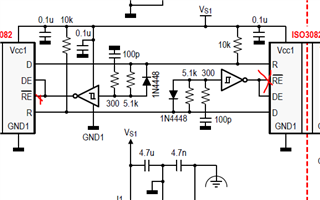Other Parts Discussed in Thread: ISO3082, , ISO3080
Hello Expert,
There may be some unreasonable part in my question, so please forgive me.
Our customer is under design w/ this part.
This application is fire alarm system and communicate RS-485 between main receiver and other local receivers.
Here is my questions.
1. If RS485 communication (full duplex) needs to be done up to 3km, can I use a repeater or amplifier in the middle?
Please introduce a circuit diagram or parts that you can recommend. also share app. note.
2. If we use full duplex, What are the specifications of the wire?
3. If one main fire receiver and 13 local fire receivers are connected,
Do we need separate control to communicate for data transmission?
Or is it possible to communicate by automatically checking the line in the communication chip?
4. Communication distance (1km) If the total data communication amount is 93,600 bytes, what is the communication processing time?
5. Do you have reference circuit design data?
Best regards,
Michael


